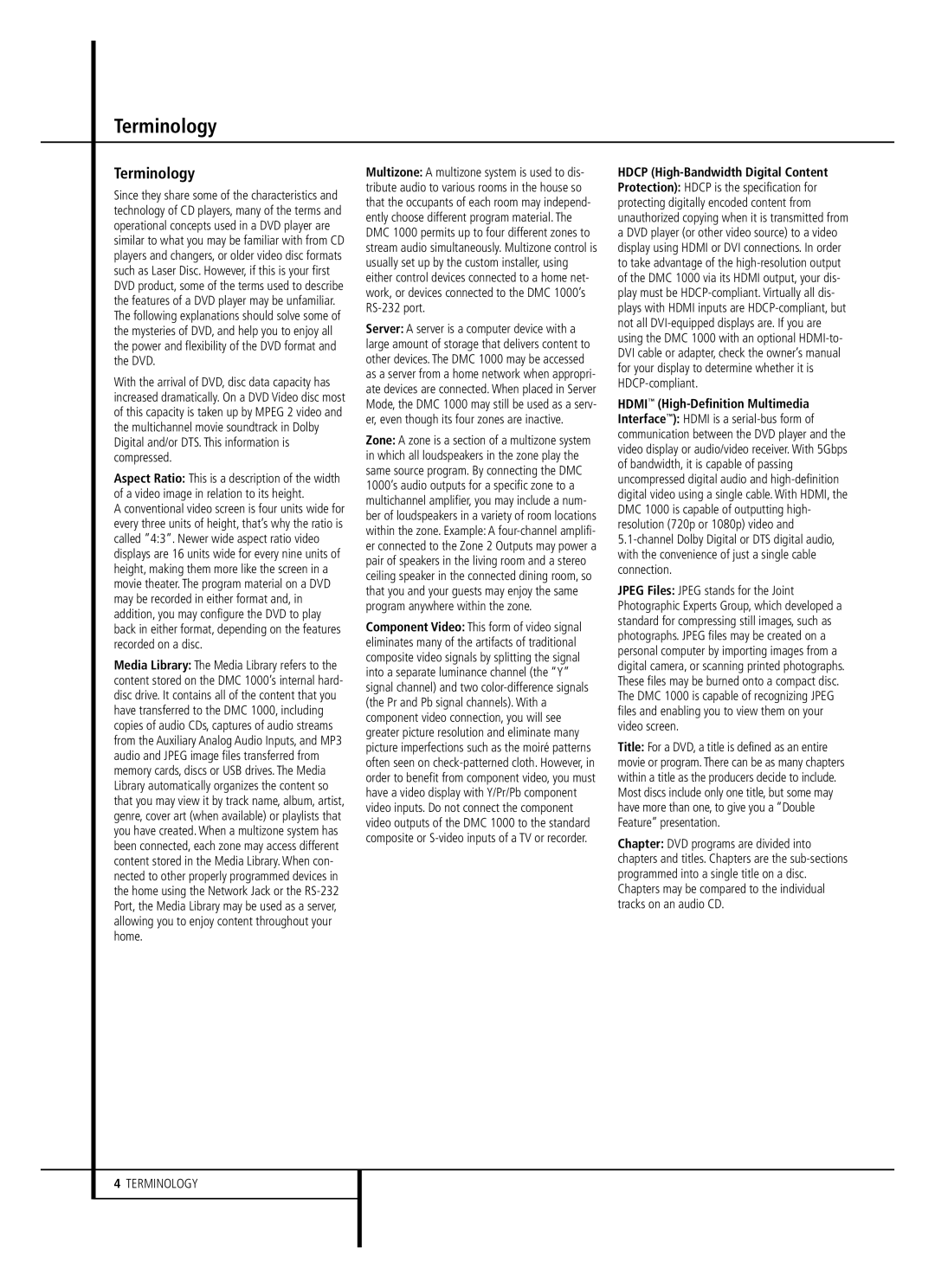
Terminology
Terminology
Since they share some of the characteristics and technology of CD players, many of the terms and operational concepts used in a DVD player are similar to what you may be familiar with from CD players and changers, or older video disc formats such as Laser Disc. However, if this is your first DVD product, some of the terms used to describe the features of a DVD player may be unfamiliar. The following explanations should solve some of the mysteries of DVD, and help you to enjoy all the power and flexibility of the DVD format and the DVD.
With the arrival of DVD, disc data capacity has increased dramatically. On a DVD Video disc most of this capacity is taken up by MPEG 2 video and the multichannel movie soundtrack in Dolby Digital and/or DTS. This information is compressed.
Aspect Ratio: This is a description of the width of a video image in relation to its height.
A conventional video screen is four units wide for every three units of height, that’s why the ratio is called ”4:3”. Newer wide aspect ratio video displays are 16 units wide for every nine units of height, making them more like the screen in a movie theater. The program material on a DVD may be recorded in either format and, in addition, you may configure the DVD to play back in either format, depending on the features recorded on a disc.
Media Library: The Media Library refers to the content stored on the DMC 1000’s internal hard- disc drive. It contains all of the content that you have transferred to the DMC 1000, including copies of audio CDs, captures of audio streams from the Auxiliary Analog Audio Inputs, and MP3 audio and JPEG image files transferred from memory cards, discs or USB drives. The Media Library automatically organizes the content so that you may view it by track name, album, artist, genre, cover art (when available) or playlists that you have created. When a multizone system has been connected, each zone may access different content stored in the Media Library. When con- nected to other properly programmed devices in the home using the Network Jack or the
Multizone: A multizone system is used to dis- tribute audio to various rooms in the house so that the occupants of each room may independ- ently choose different program material. The DMC 1000 permits up to four different zones to stream audio simultaneously. Multizone control is usually set up by the custom installer, using either control devices connected to a home net- work, or devices connected to the DMC 1000’s
Server: A server is a computer device with a large amount of storage that delivers content to other devices. The DMC 1000 may be accessed as a server from a home network when appropri- ate devices are connected. When placed in Server Mode, the DMC 1000 may still be used as a serv- er, even though its four zones are inactive.
Zone: A zone is a section of a multizone system in which all loudspeakers in the zone play the same source program. By connecting the DMC 1000’s audio outputs for a specific zone to a multichannel amplifier, you may include a num- ber of loudspeakers in a variety of room locations within the zone. Example: A
Component Video: This form of video signal eliminates many of the artifacts of traditional composite video signals by splitting the signal into a separate luminance channel (the “Y” signal channel) and two
HDCP
HDMI™
JPEG Files: JPEG stands for the Joint Photographic Experts Group, which developed a standard for compressing still images, such as photographs. JPEG files may be created on a personal computer by importing images from a digital camera, or scanning printed photographs. These files may be burned onto a compact disc. The DMC 1000 is capable of recognizing JPEG files and enabling you to view them on your video screen.
Title: For a DVD, a title is defined as an entire movie or program. There can be as many chapters within a title as the producers decide to include. Most discs include only one title, but some may have more than one, to give you a “Double Feature” presentation.
Chapter: DVD programs are divided into chapters and titles. Chapters are the
4TERMINOLOGY
